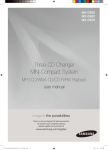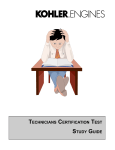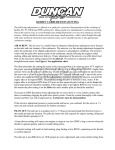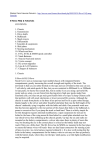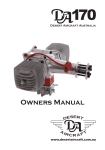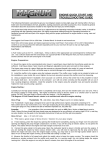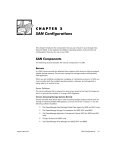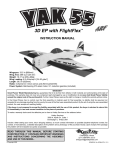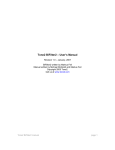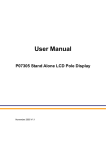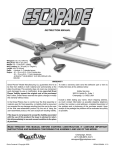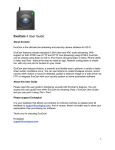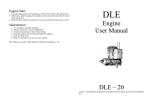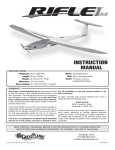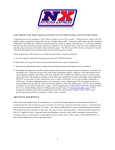Download O.S. 110FS
Transcript
Engine Test column ENGINE TEST BY: Mike Hoffmeister O.S. 110FS mounting-bolt pattern as the FS-91SII. It also has innovative features which nearly eliminate fuel and oil mess in the engine compartment. It has a reversible carburetor, which allows installation flexibility and it can happily swing a large range of propeller sizes. Plus, it’s backed by a two-year warranty policy. While engines in this size range are not inexpensive, you can usually take advantage of a discount offer at towerhobbies. com to take a chunk out of the purchase price. -a Four-Stroke Glow Engine O.S. is well known for quality products and innovation, plus they have countless years of experience with four-stroke glow-powered engines. In 2007, they introduced the 56FS-a, the first in the new “Alpha series” lineup of four-stroke glow engines. Next came the 81FS-a, followed by the 110FS-a, which is the subject of this review. These new “Alpha series” engines feature an all-new look, plus some interesting new features aimed at minimizing the mess in and around the engine compartment of your favorite airplane—all with mounting interchangeability, light weights, and compact sizes that make them easy to install into many airplanes. W hy to Buy The 110FS-a is easy to start and tune, has excellent idle characteristics, transition, and power—plus it fits the same Breakin and Performance Testing I used Cool Power 20% heli fuel for break-in and all testing. I have found that higher nitro content in four-stroke engines improves the idle, transition, and ease-oftuning—plus it gives a slight boost The O.S. 110FS-a comes well packed in a high-quality bubble-pack envelope and box and includes muffler, instructions, decals, and a flexible extension plus knob for the high-speed needle valve. This side view shows off the 110FSa’s compact size, cool new look, and superb finish. This front view clearly shows the new cooling fin arrangement, narrow profile, and machined-aluminum pushrod tubes. The new logo on the rocker cover is also a nice touch! This rear view shows how O.S. has angled the intake manifold to get the carburetor centered side-to-side. Reversing the carburetor is a two-minute job, plus access to the needle valve and glow plug is easy. in power, particularly when running a higher-load propeller. So I went with the highest nitro percentage recommended in the instructions. Just make sure that the fuel you select complies with the requirements listed in the user manual. The manual lists a huge range of propellers that are suitable for the engine, from a 13x9 on up to a 16x8. I have several propellers in this size range, so I elected to test five different propellers that were previously used to test a similar size fourstroke glow engine. This Engine Test column includes the APC 16x6 and 15x10, Master Airscrew 15x6 and 16x6, and the Xoar 15x8. After securing the engine to the test stand, fueling the test stand tank, connecting the hoses and double-checking everything, I slowly turned over the engine a few revolutions until I saw fuel in the hose all the way up to the carburetor. Then I turned it a couple more revolutions. A quick bump from a Sullivan Dynatron starter immediately brought the engine to life! The 110FS-a engine and F-5040 muffler both share distinctive styling and the muffler mounting offers 360-degree adjustability. The 110FS-a is shown in action mounted to my thrust test stand with the camera flash freezing the APC 16x6 prop. The throttle servo can be controlled by radio control using a Spektrum DX7 radio for break-in and carburetor tuning, or switched over to computer control for a test run, with all data being displayed and recorded by the computer. The 110FS-a is attached to the test stand via adjustable mount legs. The small circuit board just behind the propeller hub is the optical tachometer, which is part of the Medusa Research “Power Analyzer Pro” data system. The break-in process requires running the engine wide open, but with a widely varying highspeed needle setting. Basically, you run the engine very rich for several seconds, then lean it until rpm come up and it’s running clean at near-peak revolutions. Hold it for a few seconds and then immediately richen the high needle until the engine slows considerably and starts blowing a lot of smoke and fuel mist from the exhaust, then repeat. Over the course of the first two tanks of fuel, this process is repeated over and over, with steadily increasing durations of nearpeak rpm periods of operation. This process is intended to run the engine through varying loads and rpm ranges, and also to heatcycle the engine by getting it warm during running done with near-peak needle settings, then cooling and lubricating it quickly with a great amount of fuel when the needle is opened for the periods of rich running. Once the break-in was complete, I tuned the low and high needles in a back-and- At first this looks like “just another engine hardware layout” but it’s worth taking a very close look at each part. This engine is truly a work-of-art, with casting quality, machine finish, and an overall parts’ fit that is second-to-none! forth manner until I had a slow and steady idle with clean acceleration, even when the throttle was opened rapidly. I set the high needle about 200 rpm on the rich side of peak (a few clicks more open on the high needle than the setting that produces highest rpm). The instructions include a clear, step-by-step approach at tuning the carburetor. With the larger propellers, the engine could easily hold 1800 to 1900 rpm idle without stumbling upon quick throttle opening, and it also held steady rpm at full throttle. The exhaust note is quite pleasing, with the dual-chamber On the left is a view of the cylinder head with the rocker cover and intake valve/spring/retainer removed. Note the small hole below the valve spring seat—this is where the excess lubricating oil is routed to the intake port to be “recycled” thereby eliminating the need for a messy crankcase breather. On the right, a view of the combustion chamber with the intake valve removed shows the same small hole (just above the larger valve guide hole). Engine Test column standard test that I run has the engine running for five seconds at stable idle, then five seconds at 20% throttle, then five seconds at 40% throttle, and so on, with the final five seconds at wideopen throttle. All the while, the data system is capturing rpm, thrust, ambient temperature, and cylinder head temperature (on the back side of the head, between two fins). In a test taking The crankshaft is a beefy one-piece unit with a super-smooth precisionground surface on the areas that mate with the crankshaft bearings and connecting rod bearing. aluminum muffler doing a nice job minimizing noise. I plan to start reporting sound levels in my future engine reviews, but did not get the data in time for this one. For this size engine, the 110FS-a has a soft exhaust note, which is pleasing to the ear and to your neighbors around the airfield. The first propeller I ran, for break-in and performance testing, was the APC 16x6. It turned an impressive 9,025 rpm, producing just under 14 lb of thrust, with a 51 mph pitch speed. Idle was very steady and the engine simply ran flawlessly, regardless of throttle movements or extended periods of idling. The test stand is run and monitored by computer, so it’s possible to do exactly the same test over and over with minimal variation. The The piston is fully CNC-machined from bar stock with careful attention to weight reduction while retaining rigidity and strength. This close-up of the connecting rod shows the “beefiness” of the part and finish quality that O.S. is known for. The 60Y carburetor is reversible and has proven to perform well and tune easily. The extended venturi tube helps minimize reversion (spit-back of fuel out of the carb inlet) which makes the engine cleaner-running and a bit more fuel efficient. The F-5040 muffler allows substantial installation flexibility since the muffler can be rotated a full 360-degrees; the outlet can be angled by rotating the rear muffler part relative to the front. Here is a close-up of the crankshaft, showing the helical-cut gear teeth, lobes, and alignment mark used to assure correct timing during installation. This close-up of the crankcase casting shows off the great lengths that O.S. developed in order to minimize weight and size while maximizing cooling efficiency and rigidity. less than one minute, a large amount of data is captured, which then allows graphing of the results for easy interpretation and comparison of various propellers. After this first test, I then changed propellers several times until I had a good clean test run for each of the five propellers included in this review. I found that the high needle did need to be adjusted with each propeller change, but most of the time it was only a few clicks. The one exception was the APC 15x10 propeller. This one produced significantly more load than the others, and it required a much richer setting on the high needle to avoid a lean condition and detonation. For this propeller, I had the high-speed needle about a half-turn richer than for the lowest-load propeller tested, the Master Airscrew 15x6. I was very impressed with how well the engine ran with a very wide range of propellers. From the lightest load to the heaviest load propeller, the peak rpm covered a range of nearly 2500 rpm, but with each propeller it ran like a top! Engine Hardware Layout All four-stroke engines involve a certain amount of complexity to disassemble (and more importantly to reassemble) due to parts’ count, and items like getting valve keepers back in place and cam timing set correctly. But I have to say the O.S. 110FS-a is as easy as they come. The engine does not use any paper gaskets, with all interfaces being sealed by rubber seals, or metal-to-metal contact of the very finely-machined surfaces. This makes maintenance much easier, with minimal fear of experiencing a torn gasket. Also, the propeller hub is locked (rotationally) to the crankshaft by a key, so it isn’t necessary to use a puller to get the drive hub off the crankshaft— it simply slides off, allowing the key to be picked out with bare fingers. The 110FS-a features a lubrication scheme that eliminates the overboard crankcase breather (that is common to most four-stroke glow engines), by directing excess lubricating oil that accumulates in the crankcase forward through the crankshaft, up through the cam box and pushrod tubes, and into the rocker-cover area, where it is finally fed to the intake port to be “recycled.” Engine Test column This table shows the top rpm, static thrust, and pitch speed achieved with each propeller tested. RPM Static Thrust (lbf) Pitch Speed (MPH) APC 15X10 8,075 11.2 76.5 APC 16X6 9,025 13.9 51.3 Master Airscrew 15X6 10,475 12.8 59.5 Master Airscrew 16X6 9,625 14.3 54.7 Xoar 15X8 8,700 12.3 65.9 Conclusions The O.S. 110FS-a provides a substantial power increase vs. the FS-91SII (which it shares mounting bolt pattern and overall size with) and it delivers very similar performance to competing engines in the same size range in a package that is compact and lightweight. It is easy to tune, produces excellent This view of the crankshaft shows two small holes that are part of the oil system. The larger hole to the right of the cam drive gear directs most of the excess oil from the crankcase up into the cam box, while the smaller hole to the left of the cam drive gear provides lubrication to the front ball-bearing which supports the crankshaft. Thrust vs. RPM power, and happily swings a very wide range of propellers. It is one of the cleanest running four strokes I have ever seen, due to the unique lubrication system and extended carburetor venturi. Whether you are equipping a new model or upgrading the engine on an existing model, the O.S. 110FS-a is a great choice. To see and hear the engine run, please see the video at rc-sf.com. 14 Engine Test Specifications Static Thrust (lbf.) 12 Type Four-Stroke Glow-ignition engine Displacement 1.10 cu in. (18 cc) Bore 1.196 in. (30.4 mm) Stroke .976 in. (24.8 mm) Cylinders Single Total Weight 21.5 oz (672 grams) Engine (Only) Weight 19.2 oz (600 grams) Muffler Weight 2.3 oz (72 grams) Crankshaft Threads 5/16-24 Propeller Range 13x9 – 16x8 Rpm Range 2000 to 11,000 rpm Fuel 5-20% nitro Mounting Dimensions See towerhobbies.com Muffler Type Cast, dual-chamber Cylinder Type Plated sleeve Carb Type Barrel, Two Needle Valve Crank Type Dual Ball Bearing 10 8 6 4 APC 16X6 APC 15X10 2 Master Airscrew 16X6 Master Airscrew 15X6 Xoar 15X8 Wood 0 2,000 3,000 4,000 5,000 6,000 7,000 8,000 9,000 10,000 11,000 RPM This graph shows how thrust relates to engine rpm for each of the five propellers tested. Thrust vs. Pitch Speed Thrust vs. Throttle Position 16 16 14 14 12 Static Thrust (lbf.) 12 Static Thrust (lbf.) As the oil flows through these various passages and parts of the engine, it is serving the purpose of lubricating the various parts along the way. O.S. has also added a purposefully designed long venturi tube that attaches to the inlet side of the carburetor to minimize spit-back (more accurately called “reversion”). The other benefit of this venturi tube—by eliminating fuel lost out of the carburetor, fuel efficiency is slightly improved. I found the engine to stay quite clean and dry, with very little fuel/oil mist landing on and speckling the test stand. About the only engine maintenance required for the 110FS-a is the occasional adjustment of valve clearance. This is well documented in the instruction manual, including illustrations. As the engine breaks in, the valve clearance can change slightly and readjustment of the clearance is necessary to maintain optimum performance. If allowed to get too tight, the valves may not fully close, allowing leakage and loss of compression. If valve clearance gets excessively large, there will be an increase in valve train noise and power loss due to the valve not opening as far or staying open as long. This is nothing new for the 110FS-a, and it is common to all four-stroke RC aircraft engines. I checked the clearances after all of the test running and found them to be within specification, so no adjustments were required. I have found O.S. engine castings and finish machining to be of extremely high quality, but they have raised the bar even further with this engine! I have never seen casting so finely finished, with sections carefully thinned down for weight savings. O.S. 110FS-a Four-Stroke Glow 10 8 6 10 Engine Test 8 APC 16X6 APC 16X6 APC 15X10 APC 15X10 Master Airscrew 16X6 2 Master Airscrew 16X6 2 Master Airscrew 15X6 Master Airscrew 15X6 Xoar 15X8 Wood Xoar 15X8 Wood 0 0 0 10 20 30 40 50 60 70 80 Great Planes P.O. Box 9021 Champaign, IL 61821 Phone: 800-637-7660 Web site: greatplanes.com 6 4 4 90 100 Throttle Stick Position (%) This graph shows how thrust output varies with throttle position. As throttle is advanced to about 80%, there is a steady increase in thrust, and past 80%, thrust remains relatively constant. As an example, for an 8 lb 3D airplane, a Master Airscrew 16x6 prop would hover the plane at about 30% throttle. 0 10 20 30 40 50 60 70 Vendors 80 Pitch Speed (MPH) This graph shows how static thrust and static pitch speed relate to each other. For maximum static thrust, pick the one with highest thrust but to trade off some static thrust for more pitch speed, this graph provides visualization of the trade-off. Medusa Research, Inc. 288 Plymouth Avenue Fall River, MA 02721 Phone: 508-675-0202 Web site: medusaresearch.com Tower Hobbies P.O. Box 9078 Champaign, IL 61826-9078 800-637-4989 (orders) Web site: towerhobbies.com





